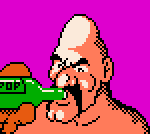

I made the control panel from the same kind of cheesy Sauder 5/8" mdf/particle board. I found a template on the net for the button spacing. The buttons have about 1/8" inch inbetween them and the buttons are spaced about 3.5" inches from the joystick. I used a 1 1/8" spade drill bit to make the holes for the buttons and the joystick.
For the uninitiated, the way the MAME control panel works is that it acts as a "keyboard" sending commands to the computer, but through button presses and joysticks instead of keys. For a while, one had to hack a keyboard for this purpose. These days though, there are a few companies such as Ultimarc and Groovy Game Gear that create small encoders that help make wiring buttons up and configuring them very, very easy. For this project I used an Ultimarc "MiniPac Opti" that came with a wiring harness and the ability to hook up a trackball to it to make things even easier. Looking back, this type of already-made package is great for the beginner, however now that I've gotten my feet wet in this hobby, I can see the advantages of doing the wiring from the encoder to the buttons yourself. Basically, it's more tedious to make the wiring yourself but you can customize the lengths and such for a very clean looking installation.
The buttons are Happs blue translucent microswitch buttons. Microswitch buttons weren't the norm back in the 80's, instead they often used leaf switches. Leaf switches are quieter, and there's more of a plastic "tap" sound than the "click" you get when you press microswitch buttons. I prefer leafswitches because I remember that hollow, plastic tapping sound from when I was younger. I'm using microswitch buttons here but with leafswitch brackets from Rollie Eelectronics that are made to convert todays more common micro's to leafs.
For the joysticks, I decided to splurge a bit and get Ultimarc's Ultrastik 360's. These are really great joysticks that are programmable. In the arcades, joysticks were usually fixed at 2 way, 4 way, 8 way, 49 way or even anaolog. There are some joysticks you can buy that may be switched from 4 to 8 way and such, but the Ultrastiks can be mapped through software to emulate a 4, 8, 49 way or even anolog etc. I also purchased the circle restrictor plates that lessen the "throw" of the sticks so they move in a tighter circle. These sticks are smooth as butter with the default light spring and playing arcade games or any console emulators is excellent. You can even create customized joystick maps for certain games.
The arcade version of Punch-Out!! had a "K.O." button you could slam for big hooks and uppercuts when the punching power meter filled up. I decided to try and recreate this with a mushroom switch button from . I even managed to get a blue translucent one to go with the buttons. It wasn't cheap, but I had to have it. I then purchased a blue translucent trackball, cut into the control panel to accomodate it and routed out an area for the top trackball plate to sit flush on the control panel.
The reason I chose translucent buttons and a trackball is to light them up with leds. I first tried an unorthodox method of lighting them by using 12 volt 4 head leds strung up in parallel from the computer's power supply. I figured I would shoot the light from each of the leds up into the buttons for a nice effect. Well the effect was nice, but stringing up all those somewhat large leds and trying to position them just so was a huge pain in the ass, especially with everything else going on under the control panel. So I scrapped that and...
I noticed another member from the arcadecontrols.com forum using Groovy Game Gear's "Button Blaster" leds with great success. This method proved much easier, although I had to modify the leafswitch brackets by cutting part of them off and drilling a 3/16" hole in the buttons for each led. I then soldered the leds in parallel with resistors to the computer's power supply.
